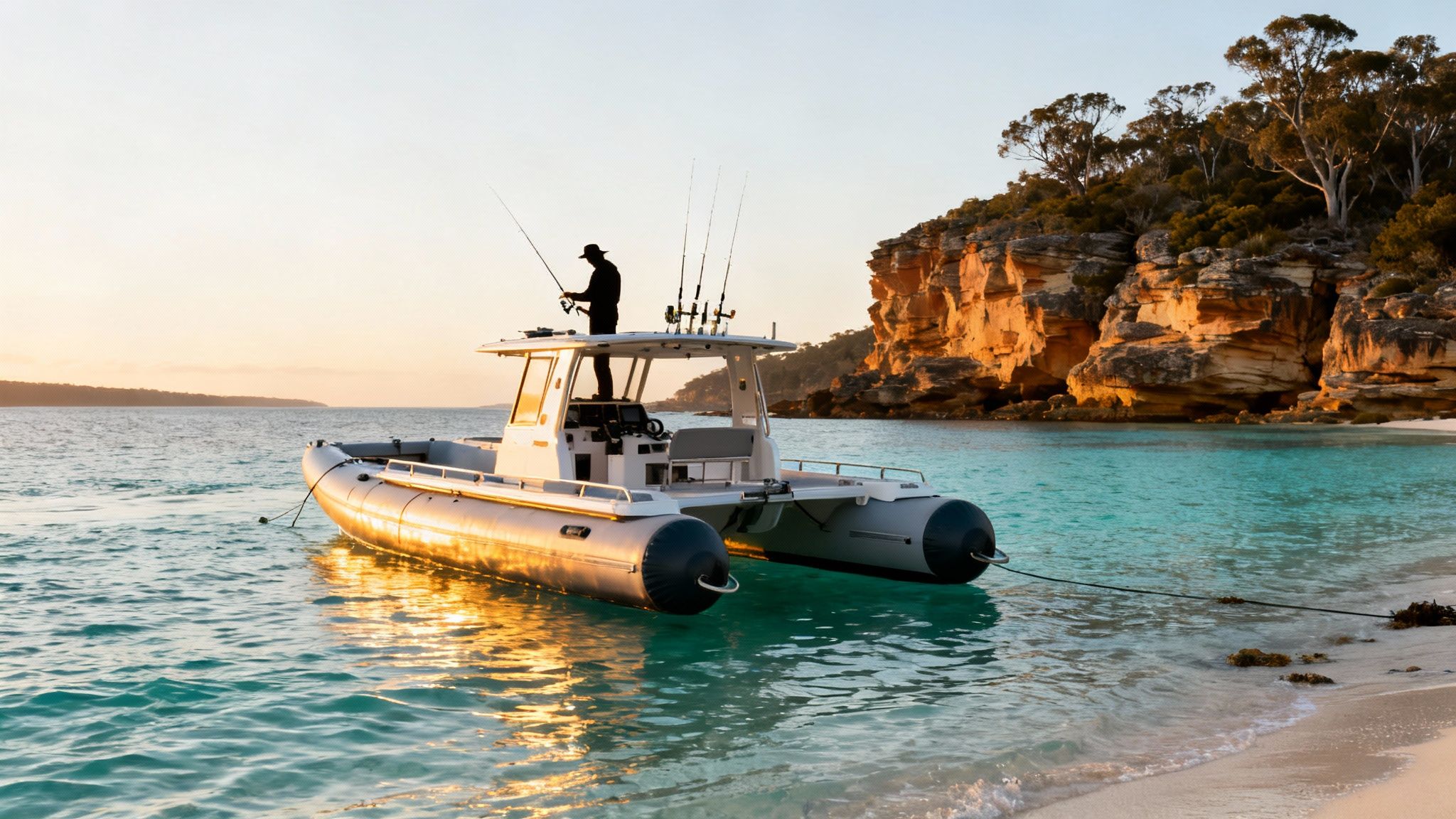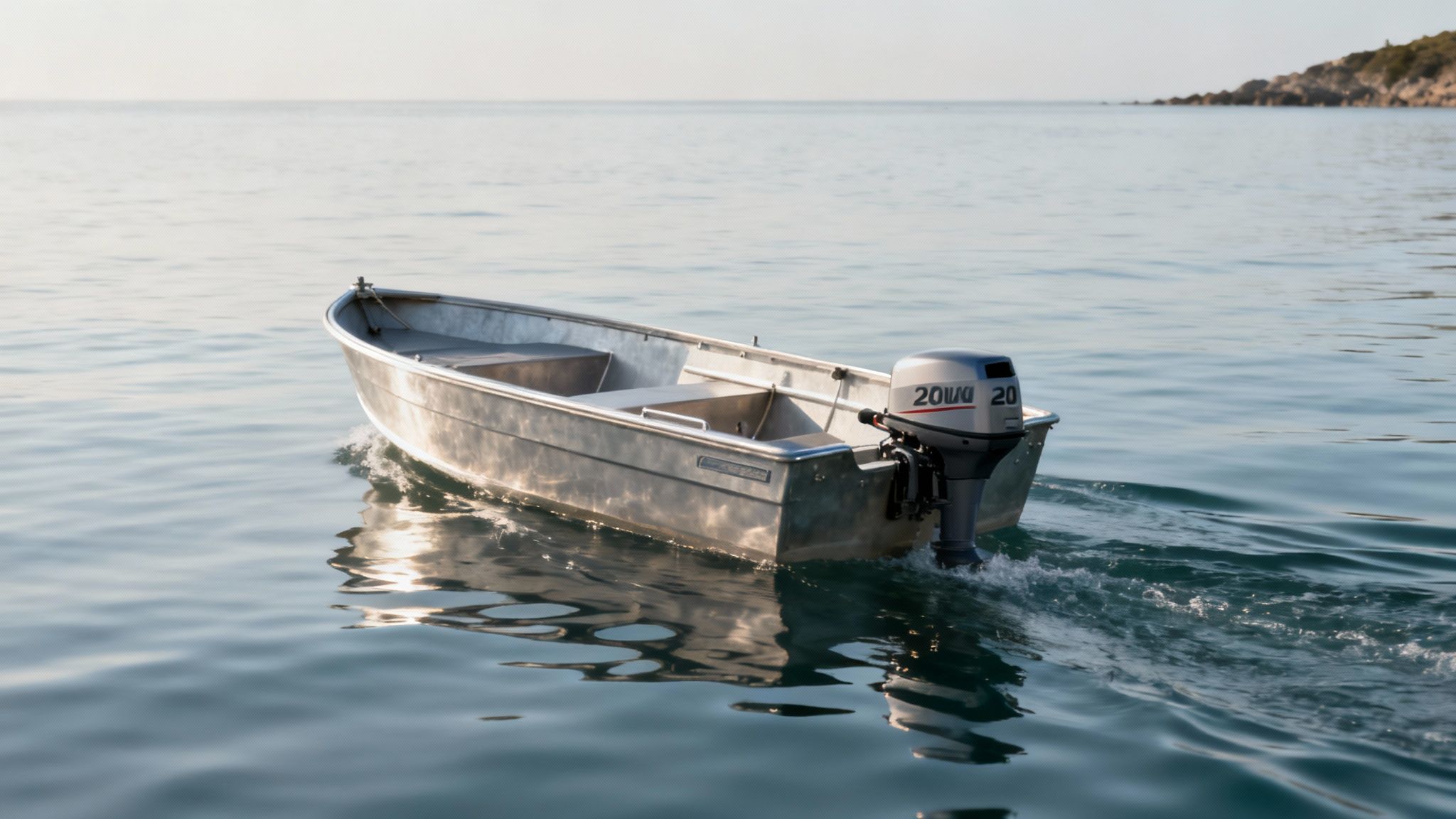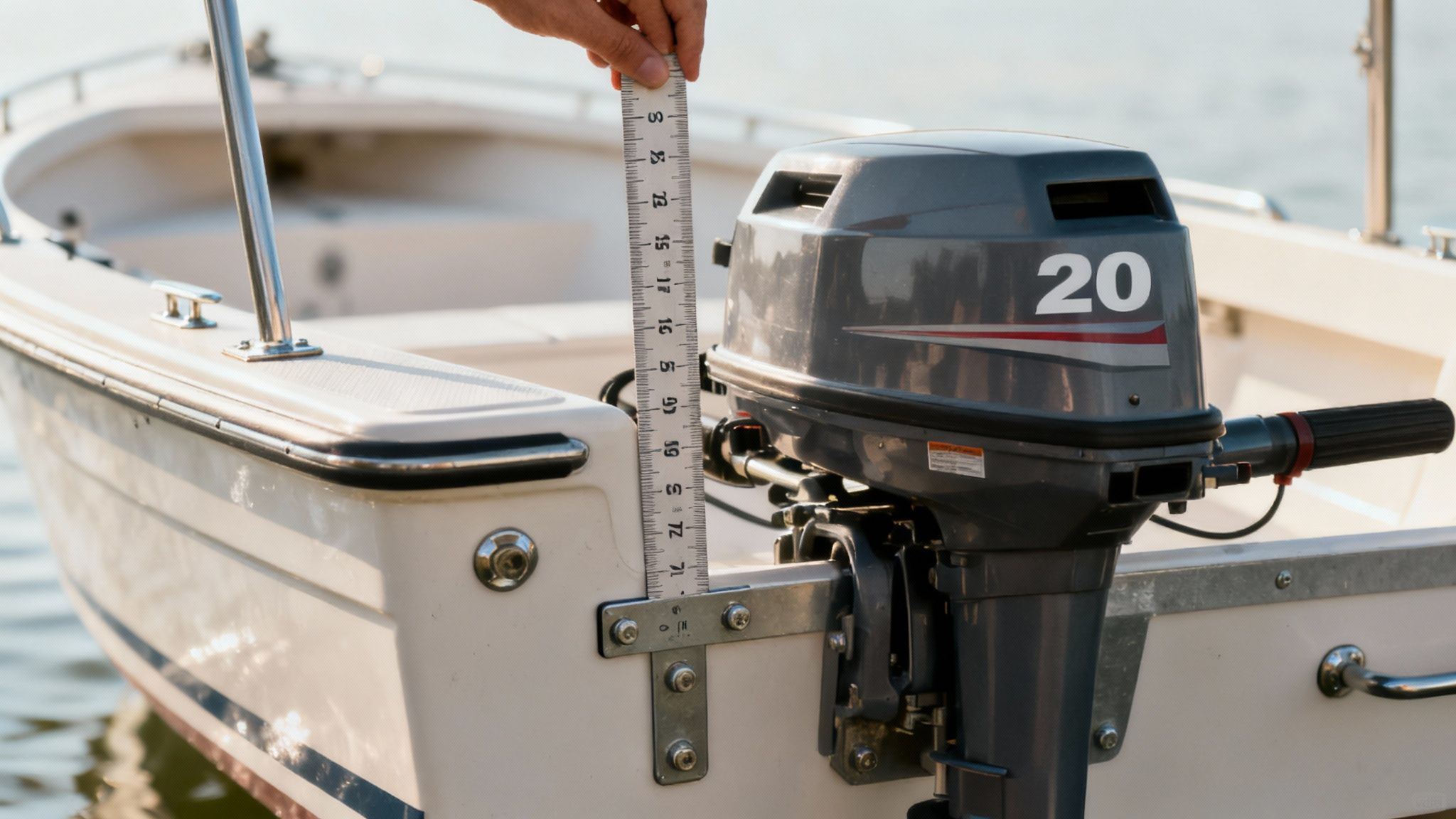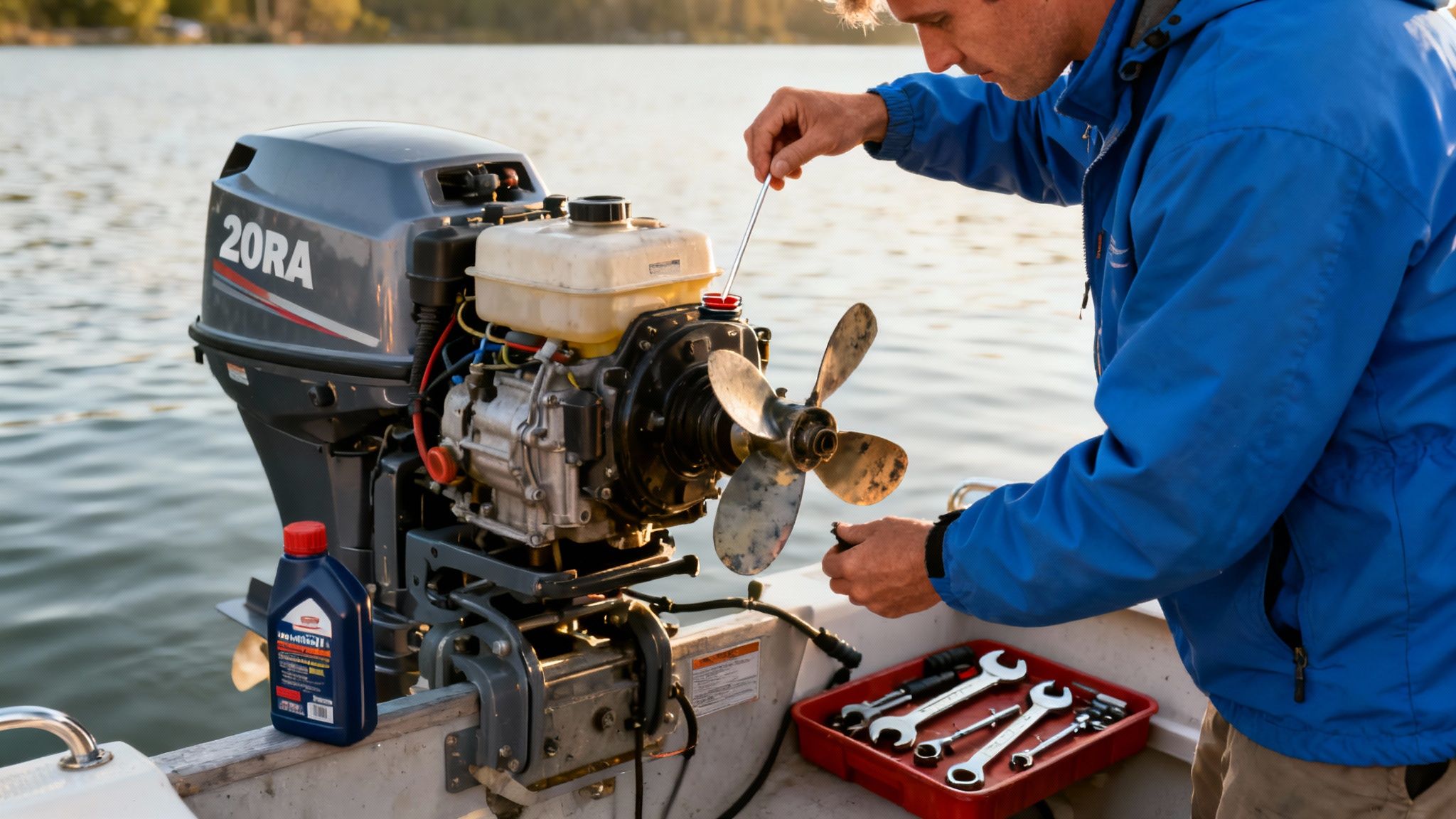
Finding the right outboard is all about hitting that perfect balance between power and portability. For countless Aussie boaters, the 20 hp outboard engine is the undisputed sweet spot. It’s got enough grunt to get small tinnies, tenders, and inflatables planing across the water with a smile on your face, but it’s still light enough to handle and transport without a hassle.

This guide is your roadmap to choosing the right motor for your adventures on Australian waterways. We'll cut through the technical jargon, stack up popular brands, and shine a light on some high-value alternatives that deliver serious performance without the eye-watering price tag. After all, getting the best bang for your buck is what it's all about.
Our goal here is simple: to give you the confidence to pick an engine that’s a perfect match for your boat and your lifestyle. Whether you’re looking for the best inflatable boats for recreational use available near you or rigging up a nimble fishing tinnie, knowing what you’re looking at is the first step.
We’ll also dive into how some of the newer brands are giving the old guard a real run for their money. You'll see how options like the Hidea 20HP standard and EFI models are proving to be a better alternative to other budget-friendly outboards like Parsun, offering features that punch well above their weight.
Think of this guide as your trusted first mate, here to help you navigate the options and find a motor that’ll keep you out on the water for years to come.
It all starts with understanding what makes a 20 hp outboard so versatile in the first place. We'll cover everything from matching an engine to your boat to the essential maintenance that keeps it running sweet. If you're just starting your search, our overview of affordable outboard motors is a great place to get a feel for what’s out there.
When you’re looking at a 20 hp outboard engine, it's easy to get lost in the technical jargon. But from my experience, only a few key specs really define how your motor will perform on the water.
The biggest fork in the road is the choice between two-stroke and four-stroke technology. While old-school two-strokes were simple and punchy, modern four-stroke engines are now the gold standard. They're quieter, far more fuel-efficient, and much kinder to the environment—perfect for long, peaceful days exploring our beautiful Australian coastlines.
The Australian market has definitely made the switch. With around 47,000 outboard units sold annually, four-stroke engines are dominating because of their efficiency and emissions compliance. The latest injection models are becoming especially popular. For a deeper dive, this comparative assessment of small marine engines has some great data on these trends.
Next up is how the engine gets its fuel. A traditional carburettor is a mechanical gadget that mixes air and fuel. They’re reliable workhorses, sure, but can be a bit fussy with temperature changes and sometimes need a bit of tinkering to run just right.
This is where Electronic Fuel Injection (EFI) really shines as the smarter, modern alternative. A Hidea 20 hp EFI engine, for instance, uses a small computer and sensors to deliver the perfect fuel mix every single time. What does this mean for you?
Finally, let's talk about the practical stuff—the three things that determine if the engine will even work on your boat. Getting these right is non-negotiable.
While a 20 hp outboard engine is a fantastic all-rounder, if you're curious about other power options, you might find our guide on electric outboard motors in Australia offers a different perspective.
When you're in the market for a 20 hp outboard engine, it's tempting to stick with the big, household names. But if you're looking to compare prices and features of inflatable boats in your area, you'll find the smartest buy isn't always the most famous one. Some newer brands are delivering incredible value by packing modern tech and solid reliability into a much more affordable package.
This is especially true when you compare the different players in the value-for-money space. While brands like Parsun have earned a reputation as a budget option, they often lag behind on the latest advancements. This is where a brand like Hidea Outboards really shakes things up, offering a better alternative that doesn’t force you to compromise on quality or features.
Hidea has quickly made a name for itself by building robust, technologically current engines. Their range, particularly the Hidea 20HP EFI outboard motor and the Hidea 20 HP EFI engine, directly challenges the old idea that you have to pay a premium for modern features like Electronic Fuel Injection.
Instead of settling for older, carburettor-based technology, you get the huge benefits of easier starts, better fuel economy, and smoother performance right out of the box. For Aussie boaters seeking an affordable and reliable package for a family outing, pairing a Hidea engine with a quality inflatable is a perfect, hassle-free choice.
This chart breaks down the key differences between Hidea's EFI and carburettor models against a standard Parsun 20HP outboard.
As you can see, the Hidea 20HP EFI model hits the sweet spot, offering modern fuel efficiency at a seriously competitive price.
To put it in perspective, let's line up the Hidea 20HP EFI against a major brand and Parsun. It quickly becomes clear where the real value lies for those looking to compare options and get the most for their money.
| Feature | Major Brand (e.g., Yamaha) | Parsun Outboard | Hidea 20HP EFI Outboard |
|---|---|---|---|
| Fuel System | EFI (Electronic Fuel Injection) | Carburettor | EFI (Electronic Fuel Injection) |
| Starting | Excellent, reliable turn-key | Manual choke, can be temperamental | Excellent, turn-key starting |
| Fuel Efficiency | Very high | Moderate | High (up to 20% better than carb) |
| Emissions | Low (meets modern standards) | Higher | Low (meets modern standards) |
| Price Point | Premium | Budget | Value-driven (mid-range) |
| Best For | Boaters prioritising brand name | Price-conscious buyers with basic needs | Smart buyers wanting modern tech without the premium price |
While the major brands deliver fantastic EFI performance, it comes with a premium price tag. On the other end, Parsun keeps costs down but sticks with older carburettor technology. Hidea bridges that gap perfectly, giving you the advanced EFI system and reliability you want at a price that makes sense.
When you start comparing features and prices, you realise value is about more than just the upfront cost—it’s about the entire experience of owning and using the motor. Hidea Outboards are pushed as a better alternative to Parsun outboards because they deliver superior, modern technology at a highly competitive price point.
Hidea leans into this shift by making advanced EFI technology accessible to everyone. They’ve positioned their engines as a superior choice over carburettor-based alternatives like Parsun, delivering the performance and reliability boaters demand without the eye-watering price.
Ultimately, choosing a Hidea 20 hp outboard engine means you're investing in a motor that’s both dependable today and ready for the future. By offering better fuel management and effortless turn-key starting, Hidea gives you a clear advantage when it comes to maximising your time and enjoyment on the water. To see just how they do it, check out our deep dive into why Hidea outboard motors are so value-driven.

Choosing a powerful 20 hp outboard engine is a great start, but getting the right match for your boat is absolutely critical for performance and, more importantly, safety. Sticking an overpowered or overweight engine on the back can make a boat unstable and downright dangerous, so your first job is to check its limits.
Every boat has a small metal plate on the transom, known as the Australian Builders Plate (ABP) or capacity plate. Think of this plate as your boat’s instruction manual. It tells you the maximum horsepower and total weight it can safely handle. Treat these numbers as gospel—they aren’t just friendly suggestions.
Once you've confirmed the horsepower and weight limits are a match, the next critical piece of the puzzle is the shaft length. It's a bit like buying a pair of trousers; you need the right leg length for a proper fit. An outboard's shaft has to be the correct length for your boat's transom height.
Get this wrong, and the propeller won't sit at the right depth in the water. Too high, and it will suck in air (a problem called ventilation). Too low, and it will create a heap of unnecessary drag, killing your performance.
Getting it right is simple. Just measure the height of your transom, from the top edge where the engine mounts down to the bottom of the hull. This measurement tells you whether you need a short or long shaft motor.
This quick check ensures your new 20 hp outboard engine performs exactly as it should, giving you efficient power and predictable handling. For anyone looking at inflatable options, our guide to choosing the best small fishing boats offers more tips on matching boats with the right motors.

From the box to the bay, setting up your new 20 hp outboard engine is refreshingly straightforward. The first and most important job is to securely mount the motor to your boat's transom. Take your time to make sure the clamps are tightened evenly and firmly—you don't want any wobbles out on the water.
Once it's locked in place, it's time to connect the fuel system. This is usually just a case of attaching the fuel line from the tank to the engine's connector. Most modern outboards feature a quick-connect fitting that clicks securely into place, making it simple and safe. If you're new to this, getting familiar with the parts of an outboard engine fuel line is a great way to build your confidence.
Before you launch, a quick check-over can save you a world of headaches later.
Looking after your investment doesn't take a mechanic's toolkit, just a few simple habits. Good, regular maintenance is the secret to keeping your 20 hp outboard engine happy and reliable for years to come.
The single most important thing you can do, especially for us boaters in Australia dealing with saltwater, is to flush the engine with fresh water after every single trip. This simple step prevents salt build-up and corrosion, the arch-nemesis of any outboard.
A quick 5-minute flush after each trip is the best defence against saltwater corrosion. It's the number one thing you can do to extend the life of your outboard.
On top of that, get into the habit of regularly checking the engine oil and gearcase oil levels. Finally, if you're storing the motor for a while, treat the fuel with a stabiliser. This stops the fuel from going stale and gumming up the system. These easy steps will keep your engine in peak condition, ready for your next adventure.
Picking the right 20 hp outboard is a big decision, and it’s normal to have a few last-minute questions floating around. Getting clear, straight-up answers is the key to buying with confidence. Here are some of the most common queries we hear from Aussie boaters just like you.
Yes, in nearly every Aussie state and territory, you’ll need a marine licence to skipper a boat with a 20 hp outboard. While the rules can differ slightly from place to place, this power level is well past the threshold for unlicensed boating.
Take Queensland or New South Wales, for example. You need a licence for any boat that can do over 10 knots. A 20 hp motor on a small tinny or inflatable will blow past that speed with ease, making a licence a must-have. Your best bet is to always check with your local maritime authority to get the specific rules for your waters.
This is the million-dollar question! The top speed of a 20 hp outboard really comes down to the boat it’s attached to, how much weight you’re carrying (people and gear), and what the water is doing that day.
On a lightweight inflatable or a small aluminium tinny with one person on board, you can expect to hit speeds between 15 to 20 knots (that's about 28 to 37 km/h). Chuck in a mate and an esky, and your top speed will naturally drop a bit, but you'll still have more than enough grunt to get on the plane quickly and cruise efficiently.
Fuel efficiency is where modern four-stroke outboards really shine, especially the EFI models. If you’re running it flat out at wide-open throttle, a 20 hp outboard engine will probably sip around 6 to 8 litres of fuel per hour.
But here’s the clever part: when you back off to a comfortable cruising speed (around 75% throttle), fuel use drops right down, often to just 3 to 4 litres an hour. That makes a 20 hp motor an incredibly economical choice for a full day out on the water without breaking the bank.
You bet. A 20 hp four-stroke is an awesome motor for trolling. These engines are built to run smoothly and quietly at super low RPMs for hours on end, which is exactly what you need when you're chasing the big one.
The EFI models are particularly brilliant for this, as they hold a rock-steady idle speed without the old-school fuss you sometimes get with carburettors. It means you can focus on your line, not on fiddling with the engine.
Ready to find the perfect power source for your next adventure? Easy Inflatables is an authorised Australian Hidea dealer, offering the latest 20HP EFI models that deliver unmatched value and performance. Explore our range of outboards and boat packages today.
Experience the ultimate freedom on the water with our top-quality inflatable boats and accessories. Easy Inflatables is your trusted partner, providing everything you need for a safe and unforgettable adventure.
At Easy Inflatables, we believe in empowering adventurers with high-quality inflatable solutions. Our commitment to durability and performance ensures that every product enhances your outdoor experiences.